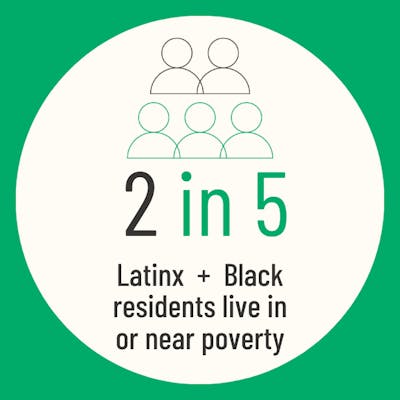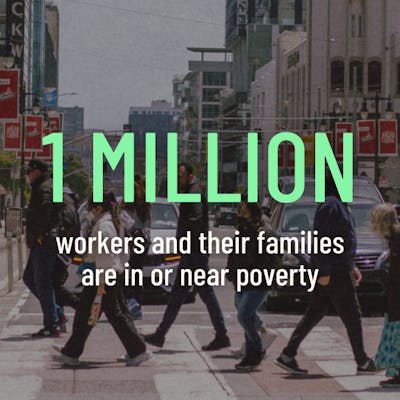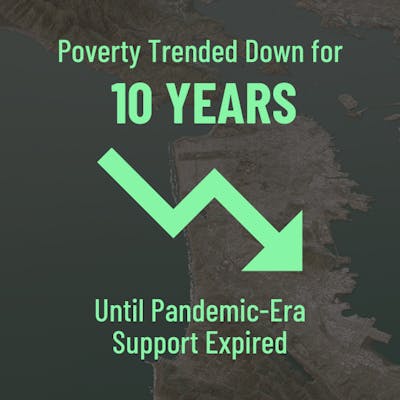Measuring the Bay Area Poverty Line
In the Bay Area, 1 in 4 residents – or 1.6 million people – are living in or at the edge of the poverty line.* Of those, about half are living below the poverty threshold, and the other half are just above.
To tackle poverty in the Bay Area, it is critical to have a clear understanding of the landscape. In 2023, Tipping Point published “Shedding Light on Bay Area Poverty,” which provides a timely portrait of poverty in our region and illustrates that while efforts to combat poverty are effective, there is still much to do. Read the Report
1. One million full-time workers and their families are in or near poverty in the Bay Area.
A full-time job does not guarantee financial security. Despite bringing home a paycheck, nearly 1 million people who are fully employed for at least part of the year do not make enough money to maintain economic security in the Bay Area. Read more of our insights on workers facing poverty in 2023.
Tipping Point supports employment organizations that build career pathways out of low-wage jobs so we can prevent poverty.
2. Latinx, Black residents, and households without a college degree are more likely to be in or near poverty.
 Stark disparities by race and education level continue to exist. Latinx and Black residents are much more likely to experience financial hardship in the Bay Area. 2 in 5 Latinx and Black residents live in or near poverty. That’s more than double the rate for white residents. Longstanding exclusionary policies, such as systemic racism across home ownership and rental practices, access to education, and employment opportunities, prevent generations of Latinx and Black residents from building wealth over time. Read more of our poverty insights on racial disparities in the Bay Area.
Stark disparities by race and education level continue to exist. Latinx and Black residents are much more likely to experience financial hardship in the Bay Area. 2 in 5 Latinx and Black residents live in or near poverty. That’s more than double the rate for white residents. Longstanding exclusionary policies, such as systemic racism across home ownership and rental practices, access to education, and employment opportunities, prevent generations of Latinx and Black residents from building wealth over time. Read more of our poverty insights on racial disparities in the Bay Area.
Tipping Point invests in communities that have had limited access to opportunity so we can address the racial wealth gap.

Residents who don’t–or can’t–pursue higher education are more likely to face poverty. Over 50% of Bay Area residents whose highest education level is a high school diploma live in or on the brink of poverty, whereas only 12% of families in which a member holds a Bachelor’s degree are in or near poverty. Read more of our poverty insights on educational disparities in the Bay Area.
Tipping Point invests in education organizations that open the door for more residents to graduate from college and achieve financial security.
3. Government benefits are an effective strategy for fighting poverty.
For the past 10 years, poverty trended down in the Bay Area, and statewide. Targeted government benefits expanded during the COVID-19 pandemic to ensure a vital safety net for residents at risk of poverty. As pandemic relief rolled back, the poverty rate increased. Statewide poverty increased at an even greater rate than in the Bay Area. Despite the uptick, poverty in the Bay Area today is still lower than pre-COVID rates. Read more about government benefits effects, including keeping 270,000 residents from dipping below the poverty line in the Bay Area in 2023.
Robust, accessible government benefits have the power to support residents in need. Tipping Point supports advocacy and policy changes to help remove barriers to economic mobility for people across the Bay Area.
*The poverty line is measured through the California Poverty Measure. View the following report publication for detailed methodology. We are grateful to the Public Policy Institute of California for developing the data contained in this report.
The report confirms that Tipping Point’s strategic approach—such as championing targeted government benefits, supporting pathways to well-paying careers, and increasing access to higher education—can shift the tide for many of our neighbors.
Learn more about the findings and see how Tipping Point is leveraging these learnings to champion the strongest solutions to ensure every member of our community is on a path to a thriving future.







